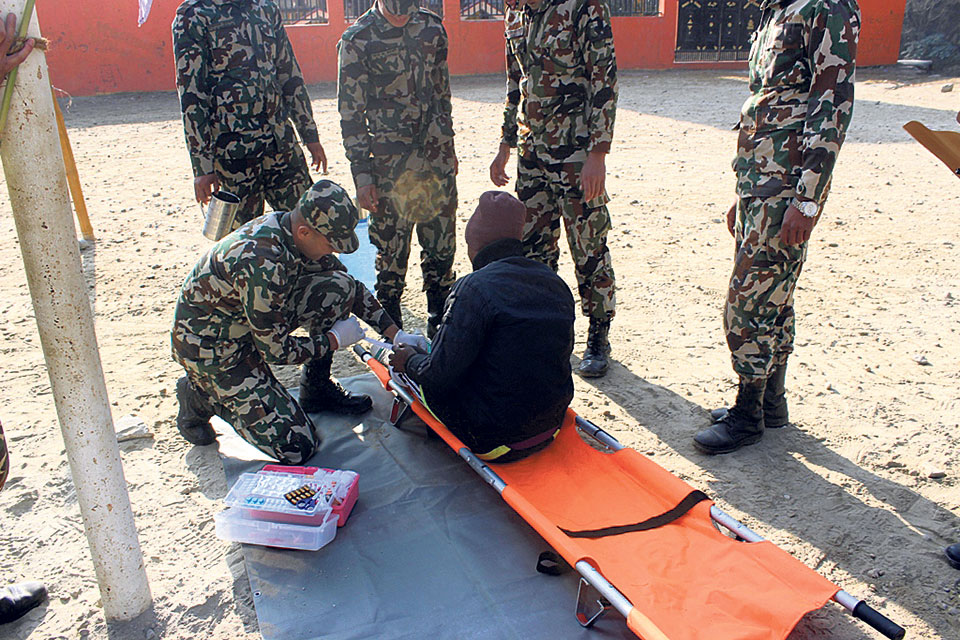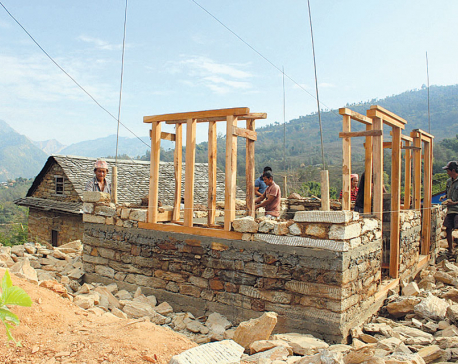
OR
Earthquake safety a largely neglected issue
Published On: January 17, 2019 10:02 AM NPT By: Biken K Dawadi

KATHMANDU, Jan 17: Although people seemed highly concerned about the safety issue and even started building earthquake-resilient building in the immediate aftermath of the major earthquakes that hit Nepal in April 2015, a large section of people across the country seem to have continued with business as usual barely three years after the major earthquakes that killed nearly 9,000 people and caused multi-billion dollars worth losses.
Even before the 2015 mega earthquakes, geologists had been warning the Nepali public repeatedly to build safer residence since Nepal lies in an active seismic zone and an earthquake could strike the country any time. But the Nepali public neglected their warning.
Finally, the earthquake that hit the country in 2015 made things clear: Earthquake cannot be predicted, nor prevented. It gave the message that the only option left is to prepare ourselves better.
But three years after the earthquakes, the general public seems to have forgotten about the heavy loss. They have yet again started turning a blind eye to the building codes and skipping crucial aspects of house construction including the soil test in order to cut down the expenses.
Geologists claim that even though we cannot prevent earthquakes, we can prevent heavy losses if the public grew aware of proper building codes and the government started to enforce the building codes strictly.
According to Geologist Ranjan Kumar Dahal, the Nepali public will not invest in building earthquake-resilient buildings until the government strictly enforces them to do so.
“Until the building codes are not enforced strictly, the ordinary public is not going to pay any attention to the building codes,” he said.
Dahal also expressed dissatisfaction over the government's failure to conduct inspections and enforce the building codes as of now.
“The building codes would have yielded a better result if a timely inspection of the structures was done,” he said.
However, the Department of Urban Development and Building Construction (DUDBC), the body responsible for tabling and implementing the building codes, claims that even though the implementation of building codes has been slow in the recent years it will catch up the pace soon.
Spokesperson of the DUDBC, Padam Kumar Mainali, claimed that the problems occurred in the implementation of safer building codes after the local locals faced technical glitches.
“The local levels have now shouldered the responsibility of inspection and implementation of the codes,” he said.
Geologist Dahal stressed that the government should carry the initiative to build earthquake hazard maps of every local unit.
“Earthquake hazard maps are very crucial in order to understand the earthquakes,” he told Republica. “It is very important to have the hazard map of every local level.”
He claimed that the earthquake safety is an issue that should be addressed urgently.
The DUDBC spokesperson, however, claimed that earthquake safety is a slow process and that all the concerned authorities should collaborate in order to build an earthquake-resilient Nepal.
“We cannot implement the codes overnight,” he said, “Even ordinary people are not yet ready to implement the building codes. It will take time to make everyone aware of the codes.”
You May Like This

April 16: 6 things to know by 6 PM today
Your daily dose of missed important news of the day. ... Read More...

Nepal faces the threat of a much stronger earthquake with magnitude of 8 or more, scientists say
More than three years after being hit by a powerful tremor, Nepal still faces the threat of a much stronger... Read More...

Post-quake reconstruction to be completed in 2 years: NRA chief
KATHMANDU, Jan 11: Chief Executive Officer (CEO) of the National Reconstruction Authority (NRA) Sushil Gyewali, has said that the ongoing... Read More...





Just In
- CM Kandel requests Finance Minister Pun to put Karnali province in priority in upcoming budget
- Australia reduces TR visa age limit and duration as it implements stricter regulations for foreign students
- Govt aims to surpass Rs 10 trillion GDP mark in next five years
- Govt appoints 77 Liaison Officers for mountain climbing management for spring season
- EC decides to permit public vehicles to operate freely on day of by-election
- Fugitive arrested after 26 years
- Indian Potash Ltd secures contract to bring 30,000 tons of urea within 107 days
- CAN adds four players to squad for T20 series against West Indies 'A'













Leave A Comment